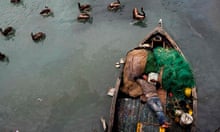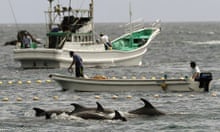The Scottish salmon farming industry is struggling to meet a controversial target to rapidly increase production to help feed China's growing appetite for fresh and smoked salmon.
The Guardian has established that Scottish salmon producers have fallen way behind their goal of increasing production by 60,000 tonnes, or 50%, by 2020 to help meet surging demand for the fish from China's middle classes. Scottish ministers now admit that hitting the target is a "challenge".
It is central to a major deal to become one of China's preferred suppliers, struck in January 2011 by Alex Salmond, the first minister, just as China signed parallel deals to lend two giant pandas to Edinburgh zoo and take a major financial stake in Grangemouth oil refinery.
In the weeks before that agreement, the Beijing government had dropped Norway as China's preferred salmon supplier in retaliation for the decision by the Oslo-based Nobel organisation to award the Nobel peace prize in 2010 to the jailed Chinese dissident Liu Xiaobo.
Scottish ministers soon promised that Scotland's fish-farming industry would rapidly expand production to 210,000 tonnes a year by 2020, to help meet Chinese demand. That is equivalent to China's total salmon consumption in 2009, which has since grown substantially.
Salmond started his fourth trade visit to China on Saturday, where he is promoting Scottish salmon and seafood. Scottish seafood producers are also flying out to China for a major trade fair on fisheries and seafood this week, to bolster the sales push.
Before leaving, the first minister said salmon exports to the Far East had leapt from 2% to 19% of all overseas sales already this year: more than half has been sold to China, with sales there now worth £20m annually.
Yet that sharp increase in exports could stall.
After hitting less than half that growth target in 2011 and 2012, Scottish salmon production is expected to fall by 10,000 tonnes this year to roughly 152,500 tonnes, the largest annual fall in nearly a decade, after being hit by a series of disease outbreaks and production stoppages.
Environmentalists now fear the missed targets could lead to salmon farmers reneging on stricter environmental standards which they recently accepted, after the industry came under intense pressure to deal with disease outbreaks, marine pollution from toxic veterinary chemicals and surges in infestation by sea lice parasites.
Paul Wheelhouse, the Scottish environment minister, insists he will not allow environmental protection to suffer, but said the Scottish Environment Protection Agency, the official body which protects water quality, is under pressure to speed up its approval system for new sites to help increase production.
He recently told a salmon industry event that hitting that target was now "a challenge", after the latest figures showed that salmon production needed to jump by 32% in six years to meet it. "So it's a substantial growth that we need to achieve. It's relatively clear to us that there is already enough capacity consented out there in Scotland for additional fish farms, in theory, to meet that demand," he told a fringe event at the Scottish National party's annual conference, but warned some farms were in the wrong place and of the wrong size.
Hitting the target depended on salmon companies agreeing to invest the millions needed to build the extra sites, he said: "I think it's doable but I can't guarantee it. It's outwith my hands. The industry is telling me they can hit this target. So we have to take this on trust."
Scott Landsburgh, chief executive of the Scottish Salmond Producers Organisation, the largest industry body, told the Guardian that the 2020 figure "gave a focus for growth". But he sounded clear notes of caution, adding: "We are optimistic that this figure will be achieved but planning consents do not follow a consistent pattern and obviously this has an impact on production figures."
Soon after Chinese salmon deal was unveiled in 2011, British anglers said they were horrified by its implications for wild fish stocks, because of the impact of sea lice infestation on wild salmon, and the risks of escaped farmed salmon having cross-bred with wild fish.
Partly in a bid to defuse those attacks, two-thirds of the Scottish industry has recently joined the Aquaculture Stewardship Council (ASC) eco-labelling and accreditation scheme, binding them to accept stricter environmental standards on water quality, pollution and damage to the wider marine environment.
Lang Banks, Scotland director for the environment group WWF, a co-founder of the ASC, said that a rush to hit the 2020 target could threaten those new industry commitments.
"It's very hard to see how the rapid expansion in farmed salmon production being expected by ministers can realistically be met without the industry having to backtrack on their pledges, under the Aquaculture Stewardship Council scheme, to reduce their impacts on the environment," Banks said. "There is a real danger that this government target could drive Scotland's salmon farmers to become less sustainable, not more."
Don Staniford, an anti-fish farm campaigner and director of the small Protect Wild Scotland group, said China should try farming its fish in closed-containment factories on dry land – a proposal now being pushed by Norwegian firms. "Not for all the farmed salmon in Norway will Scottish ministers be able to meet their targets of 50% expansion by 2020," Staniford said.
"Scottish salmon farming is dead in the water with production actually decreasing due to infectious diseases, sea lice infestation and mass mortalities. Yes, the salmon farms in Scotland are all in the wrong place – they should be located close to the market in Asia and the United States."





Comments (…)
Sign in or create your Guardian account to join the discussion